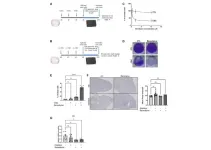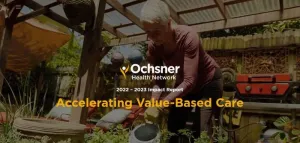(Press-News.org) In the not-so-distant future, people might be able to tune in to their favorite news source for an update on their community health status, just as they check on the local weather forecast.
The community health status is similar to the color-coded Doppler weather data that provides meteorologists with information about rain, snow or hail, its motion and intensity, which they can use to determine specific areas where dangerous weather conditions exist. Having this information has proven to be a valuable tool to protect life and property.
“The new community health report we have developed shows and analyzes for the first time the human virome –– all the known human viruses –– that are circulating in the community, by regularly and comprehensively scrutinizing public wastewater,” said Dr. Anthony Maresso professor and Joseph Melnick Endowed Chair in Molecular Virology and Microbiology at Baylor College of Medicine. “Knowing the up and down patterns within the viral landscape of human wastewater, the changes in the relative proportions of the different viruses in time and by location, is increasingly proving to be a powerful tool to improve our understanding of outbreaks, transmission and the effects on overall population health.”
First in Texas: A health visit for millions of people
Just like people periodically visit their physician to conduct a wellness exam that could detect important health changes such as early onset of diseases, a community wastewater surveillance assesses the health of the community by analyzing changes in the human virome that could point at potential emerging diseases.
Texas is the first to develop and implement a complete pipeline to conduct wastewater surveillance on the human virome, from sample collection, analysis and interpretation, to producing periodical reports on the health of communities, which are sent to public health officials.
“This is the work of the newly formed Texas Wastewater Consortium. To our knowledge, it’s the first working group to push for the introduction of comprehensive wastewater surveillance as part of our normal public health infrastructure,” Maresso said. “It is currently funded by the Texas Epidemic Public Health Institute, and Baylor College of Medicine scientists are leading the program.”
A very fancy smoke alarm
Importantly, in their ground-breaking study published in the journal Nature Communications, Maresso and his colleagues show that they can detect changes in viral trends in wastewater weeks before they are detected in the clinic.
“Think of it as a very fancy smoke alarm that brings to the attention of scientists, physicians and public health authorities the progressively increasing proportions of a particular virus strain in the community, one they need to follow closely, assessing its outbreak potential,” said first author Dr. Michael Tisza, assistant professor of molecular virology and microbiology at Baylor. “For instance, we knew about mpox (monkeypox) well before most clinical settings knew about it because we detected it in wastewater.”
The researchers believe that this valuable technology is going to be one way they can get ahead of not only all known viruses that can be shed in wastewater, but also to potentially get an upper hand on what is brewing – the next virus that we don’t yet know about.
“Had we had this in place during the time COVID-19 was emerging, we may have seen some coronavirus sequences that alerted us of the new sequence of the COVID-19 virus that began spreading in 2019 and exploded into a pandemic,” Maresso said.
How did the idea of using wastewater surveillance start?
Polio was the first virus to be monitored in wastewater. In the early 1940s, Drs. John Paul, James Trask and Sven Gard at Yale University showed that polio virus, which had been previously shown to be present in stool samples from infected people, could be detected in wastewater.
The findings, which were also independently reported by a group in Sweden, suggested that a human virus found in public excrement and wastewater might report on the state of disease at the population level. The field of environmental virology was born.
“The first example of use of environmental virology to make public health decisions occurred here at Baylor College of Medicine in the 1960s with Dr. Joseph Melnick, who was the first chairperson of the then new Department of Virology and Epidemiology (now Department of Molecular Virology and Microbiology),” Maresso said. “Melnick had worked with Paul at Yale University on polio research and developed an interest in studying the presence of polio virus in human stools and wastewater and its implications for better understanding the evolution of a disease in communities and in public health.
In 1947, Melnick, while still at Yale, reported the results of monthly tests for poliomyelitis virus in New York City raw sewage collected at a wastewater facility from 1940 through 1945. He found that that polio levels in stools and sewage are associated with the number of severe cases
in the population. In situations when the virus was not detected, no cases were reported in the tributary area. The findings led to the birth of the field of wastewater-based epidemiology.
In 1962, Melnick, now chairperson of virology and epidemiology at Baylor, applied what he had learned about polio virus in stools and wastewater to anticipate a polio outbreak and convinced the Houston public health department to push up the administration of the oral polio vaccine by five months ahead of the winter season. The vaccination program was completed in December 1962.
Melnick reported in his publication that “There were no cases of poliomyelitis reported after the vaccination program in 1962, and not a single case was reported in all of 1963. This fact and the 1962 reversal of the established monthly incidence pattern of poliomyelitis indicates the effectiveness of the vaccine.”
And then, the COVID-19 pandemic struck in 2019
For the next 80 years few people in the field were conducting wastewater analysis but it was not mainstream, and then the COVID-19 pandemic happened.
“SARS-CoV-2, the virus that causes COVID-19, is shed in human stools and in urine at very high levels,” Maresso said. “This finding revived the idea of analyzing wastewater to monitor the levels of the virus as a reliable indicator of community outbreaks. Melnick and his colleagues had used very laborious methods to detect the polio virus that offered little sensitivity, but now we had highly sensitive technologies that analyzed viral genetic materials, such as PCR and genetic sequencing.”
This was a breakthrough. Clinical testing such as analysis of nasal swabs, has a lag time before the results are available, sometimes a week.
“Also, as the pandemic progressed, people tired of testing, so scientists, physicians and public health officials did not have accurate information of the community viral load,” Maresso said. “On the other hand, analyzing wastewater, because everybody contributes to that, is a good, independent, unbiased way of monitoring community load of the virus.”
Maresso and his colleagues at Baylor were one of the first labs in the world to recognize that COVID virus could be detected in wastewater. “We started searching for it in wastewater in April 2020. Right when the pandemic was ramping up our team collected samples throughout Houston and El Paso, Texas, both of which have implemented a city-wide SARS-CoV-2 wastewater monitoring program,” Maresso said.
In the spring 2021, the 87th Texas Legislature established the Texas Epidemic Public Health Institute (TEPHI). Housed within the University of Texas Health Science Center at Houston (UTHealth Houston), TEPHI’s mandate is to work collaboratively with state, local, and federal agencies, academic institutions, professional associations, businesses, and community organizations to better prepare the state for public health threats.
TEPHI’s mission and structure is informed by lessons learned during the Texas response to the COVID-19 pandemic to address gaps in public health organization and infrastructure to better inform, train, and protect Texans. As part of the effort, TEPHI is launching numerous programs to support community preparedness across the state, including a collaboration with Baylor College of Medicine and the UTHealth Houston School of Public Health (SPH) to establish a statewide Texas Wastewater Environmental Biomonitoring (TexWEB) network.
The next big step ahead
“Fast forward a couple of years, after implementing the city-wide SARS-CoV-2 wastewater monitoring program, we asked, Could we further improve wastewater analysis as a tool for public health decisions?” Maresso said. “That’s when our team again hatched a plan to not only go after SARS-CoV-2 but to find ways to go after every human virus. We have achieved that goal, as we report in the Nature Communications paper, where we describe technologies we have developed and implemented to provide a community health report for the cities of Houston and El Paso. The goal is for the program to be statewide.”
The team developed a one-step comprehensive viral capture approach using a diverse probe set across approximately two dozen different wastewater sites on a weekly basis for nearly one year.
“Before this work, only a few viruses were ever detected in wastewater. And they were detected by PCR, the same method used to do the nasal COVID test, flu or RSV, which relies on a defined primer set that is specific for the virus in question,” Maresso said. “It’s three different tests for three different viruses. Our method is one-test-for-all 3,153 different viruses in the panel, as well as possibly new mutations in these viruses. Basically, we search for all the virome that is possible.”
This approach enabled them to identify more than 450 distinct disease-causing viruses from 28 viral families, most of which have never been detected in such samples. Sequencing reads of established pathogens and emerging viruses correlate to clinical data sets of SARS-CoV-2, influenza virus and mpox outlining the public health utility of this approach.
“We also see sequence information that PCR cannot give us that allows us to identify new viruses that might lead to the next pandemic,” Tisza said. “This is very powerful; it’s quantum leaps ahead of everything else. We think this is the way everybody is going to do it in the future.”
The researchers also developed computational tools to analyze the vast amounts of data they generate and present it in a meaningful manner.
Houston and El Paso health report
Wastewater treatment plant catchment areas serve an estimated 618,148 people in Houston and 751,982 in El Paso County. These sites were chosen because they allowed the researchers to examine the breadth and robustness of their approach across two large cities with different characteristics. For instance, Houston and El Paso differ in size and diversity, have contrasting climate and rainfall (El Paso dry and Houston humid), are geographically distant (almost 1,200 kilometers/746 miles), and have different patterns of human travel (El Paso a border city with thousands of daily cross-border commuters, Houston a coastal city with one of the largest ports in the world).
The researchers wished to understand how the human wastewater virome changed over space and time in these cities. Several virus species showed an uneven distribution between Houston and El Paso. For example, El Paso had especially strong signals from many viruses from the Parvoviridae and Sedoreoviridae families whereas Houston samples had higher prevalence of many Calicivirdae and Astroviridae, the reasons for which are currently unknown.
They also detected that the viral waves are seasonal, they repeat throughout a year. For instance, El Paso sites seem to be re-converging on their community structures from the previous year.
“This brings to mind predictability,” Maresso said. “We may be able to tell people, for example, flu season is a few weeks early this year, so you may want to get your shot early.”
Currently community health reports cover Houston, El Paso, Bownsville, South Padre Island, Lubbock, Wichita Falls, Baytown, Humble, Missouri City and Austin. The intent is for it to be statewide.
Your community health forecast may not be a part of the news yet, but this team of scientists has in place all the science, technologies and a working pipeline, and they have already shown in 10 major Texas cities that their system effectively assesses what’s in the water, can correlate it with clinical data and provide a view of what may be coming in the near future, giving us a heads up to prepare to minimize suffering and save lives.
###
END
And now, your community health forecast…
2023-12-20
ELSE PRESS RELEASES FROM THIS DATE:
A framework in your brain for organising the order of things
2023-12-20
Scientists at NTNU’s Kavli Institute for Systems Neuroscience in Norway have discovered a pattern of activity in the brain that can serve as a template for building sequential experiences.
“I believe we have found one of the brain’s prototypes for building sequences” says Professor Edvard Moser.He describes the activity pattern as “a fundamental algorithm that is intrinsic to the brain and independent of experience.”
The breakthrough discovery was published in Nature 20. December 2023.
The ability to organise elements into sequences ...
Benidipine calcium channel blocker improves cigarette smoke-induced lung emphysema
2023-12-20
A new research paper was published in Aging (listed by MEDLINE/PubMed as "Aging (Albany NY)" and "Aging-US" by Web of Science) Volume 15, Issue 23, entitled, “Benidipine calcium channel blocker promotes the death of cigarette smoke-induced senescent cells and improves lung emphysema.”
Smoking is the main risk factor for many lung diseases including chronic obstructive pulmonary disease. Cigarette smoke (CS) contains carcinogenic and reactive oxygen species that favor DNA mutations and perturb the homeostasis and environment of cells. CS induces lung cell senescence resulting in a stable proliferation arrest and a senescence-associated ...
Researchers uncover on/off switch for breast cancer metastasis
2023-12-20
Despite their promise, immunotherapies fail to treat many cancers, including over 80% of some of the most advanced breast cancers. And many of those patients who do respond still experience metastases eventually. New research from Stanford University and the Arc Institute has revealed a better way to predict and improve patient responses.
A team led by Lingyin Li, associate professor of biochemistry at Stanford and Arc Core Investigator, found that a protein called ENPP1 acts as an on/off switch that controls breast cancer’s ability to both resist immunotherapy and metastasize. The study, published on ...
Tracking roadway savings from coast to coast
2023-12-20
Oak Ridge National Laboratory researchers have identified the most energy-efficient 2024 model year vehicles available in the United States, including electric and hybrids, in the latest edition of the Department of Energy’s Fuel Economy Guide.
The annual online resource compares fuel costs for two-seaters up to large sedans, small and midsize station wagons, minivans, small and standard sport utility vehicles and small and standard pickup trucks. A quick reference top 10 list is searchable for make, model and class, too.
“With the national average of gasoline over $3 per gallon, drivers need to know how much they can save by ...
Brain lesions in former football players linked to vascular, brain changes
2023-12-20
EMBARGOED FOR RELEASE UNTIL 4 P.M. ET, WEDNESDAY, DECEMBER 20, 2023
MINNEAPOLIS – Signs of injury to the brain’s white matter called white matter hyperintensities, as seen on brain scans, may be tied more strongly to vascular risk factors, brain shrinkage, and other markers of dementia in former tackle football players than in those who did not play football, according to a study published in the December 20, 2023, online issue of Neurology®, the medical journal of the American Academy of Neurology.
“Studies have shown that athletes exposed to repetitive head impacts can have increased white matter hyperintensity burden in their brains,” ...
$6 million National Science Foundation award to Binghamton will accelerate research translation into broader societal benefits
2023-12-20
BINGHAMTON, N.Y. -- A Binghamton University team is one of just 18 nationally that will share in $100 million in U.S. National Science Foundation (NSF) funding from the Technology, Innovation and Partnerships (TIP) Directorate to accelerate the pace and scale of translational research.
The Accelerating Research Translation (ART) program will provide $6 million to Binghamton as a cooperative agreement over four years to source and grow pivotal innovations that, with help from the technology transfer office, can go to market and have a positive impact on society.
“Binghamton is quickly ...
Rise of archery in Andes Mountains dated to 5,000 years ago — earlier than previous research
2023-12-20
When did archery arise in the Americas? And what were the effects of this technology on society?
These questions have long been debated among anthropologists and archaeologists. But a study led by a University of California, Davis, anthropologist, is shining light on this mystery.
Focusing on the Lake Titicaca Basin in the Andes mountains, anthropologists found through analysis of 1,179 projectile points that the rise of archery technology dates to around 5,000 years ago. Previous research held that archery in the Andes emerged around 3,000 years ago.
The new research indicates that the adoption of bow-and-arrow technology coincided with both the expansion of ...
Ochsner Health Network announces multi-million dollar impact
2023-12-20
Ochsner Health Network, LLC (OHN), the Gulf South’s largest physician-led clinically integrated network, is pleased to report its 2022 – 2023 impact resulting from care delivered to nearly a half-million patients living throughout the Gulf South. The network’s all-new digital report boasts more than $56 million in total cost-of-care savings to our community’s most vulnerable populations, with $38 million in rewards to be shared among the network’s providers.
“Our country’s healthcare system must evolve; our communities’ health must improve; and the rising costs of care must be reversed. Proudly, Ochsner Health Network remains ...
Management of refractory or relapsed classic Hodgkin lymphoma in Brazil
2023-12-20
A new review paper was published in Oncotarget's Volume 14 on December 12, 2023, entitled, “Current perspectives on the management of refractory or relapsed classic hodgkin lymphoma in Brazil: Balancing efficacy, safety, and tolerability.”
Classic Hodgkin lymphoma (CHL), which accounts for 90–95% of all cases of Hodgkin lymphoma, is the most frequent cancer in adolescents and the most frequent lymphoma in adolescents and young adults. Despite progressive improvements over past decades and the general sensitivity of ...
Want to keep Gen-Z off vaping? Teach them about the industry’s marketing tactics, Drexel study says
2023-12-20
Young adults who are more familiar with e-cigarette marketing practices are more likely to have attitudes against vaping than those unaware of the industry’s marketing, according to a study led by Drexel University public health researchers published this month in the BMJ journal Tobacco Control. Expanding on ways cigarettes were marketed in the 1970s, such as using models and hosting smoking events, e-cigarette marketing includes more modern tactics, like paying social media influencers to promote vaping. The findings, from researchers at Drexel’s Dornsife School of Public Health and The National Institute ...




